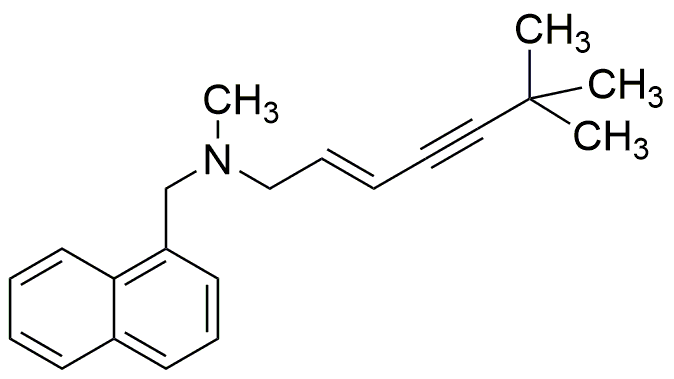Terbinafine is widely utilized in research focused on
- Antifungal Treatments: Primarily used in dermatology, it effectively treats fungal infections like athlete's foot and ringworm, providing faster relief compared to traditional treatments.
- Veterinary Medicine: Employed in treating fungal infections in pets, ensuring their health and well-being, which is crucial for pet owners.
- Pharmaceutical Development: Serves as a key compound in the formulation of topical and oral antifungal medications, helping researchers develop more effective therapies.
- Research on Drug Resistance: Used in studies aimed at understanding and combating antifungal resistance, which is a growing concern in healthcare.
- Cosmetic Applications: Incorporated in some skincare products to prevent fungal growth, enhancing the efficacy of personal care items.
Información general
Propiedades
Seguridad y normativas
Aplicaciones
Terbinafine is widely utilized in research focused on
- Antifungal Treatments: Primarily used in dermatology, it effectively treats fungal infections like athlete's foot and ringworm, providing faster relief compared to traditional treatments.
- Veterinary Medicine: Employed in treating fungal infections in pets, ensuring their health and well-being, which is crucial for pet owners.
- Pharmaceutical Development: Serves as a key compound in the formulation of topical and oral antifungal medications, helping researchers develop more effective therapies.
- Research on Drug Resistance: Used in studies aimed at understanding and combating antifungal resistance, which is a growing concern in healthcare.
- Cosmetic Applications: Incorporated in some skincare products to prevent fungal growth, enhancing the efficacy of personal care items.
Documentos
Hojas de datos de seguridad (HDS)
La SDS proporciona información de seguridad completa sobre la manipulación, el almacenamiento y la eliminación del producto.
Especificación del producto (PS)
La PS proporciona un desglose completo de las propiedades del producto, incluida la composición química, el estado físico, la pureza y los requisitos de almacenamiento. También detalla los rangos de calidad aceptables y las aplicaciones previstas del producto.
Certificados de análisis (COA)
Busque certificados de análisis (COA) ingresando el número de lote del producto. Los números de lote y de partida se pueden encontrar en la etiqueta de un producto después de las palabras "Lote" o "Lote".
Número de catálogo
Número de lote/lote
Certificados de origen (COO)
Este certificado de origen confirma el país en el que se fabricó el producto y también detalla los materiales y componentes utilizados en él y si se deriva de fuentes naturales, sintéticas u otras fuentes específicas. Este certificado puede ser necesario para cumplir con las normativas aduaneras, comerciales y regulatorias.
Número de catálogo
Número de lote/lote
Hojas de datos de seguridad (HDS)
La SDS proporciona información de seguridad completa sobre la manipulación, el almacenamiento y la eliminación del producto.
DownloadEspecificación del producto (PS)
La PS proporciona un desglose completo de las propiedades del producto, incluida la composición química, el estado físico, la pureza y los requisitos de almacenamiento. También detalla los rangos de calidad aceptables y las aplicaciones previstas del producto.
DownloadCertificados de análisis (COA)
Busque certificados de análisis (COA) ingresando el número de lote del producto. Los números de lote y de partida se pueden encontrar en la etiqueta de un producto después de las palabras "Lote" o "Lote".
Número de catálogo
Número de lote/lote
Certificados de origen (COO)
Este certificado de origen confirma el país en el que se fabricó el producto y también detalla los materiales y componentes utilizados en él y si se deriva de fuentes naturales, sintéticas u otras fuentes específicas. Este certificado puede ser necesario para cumplir con las normativas aduaneras, comerciales y regulatorias.


